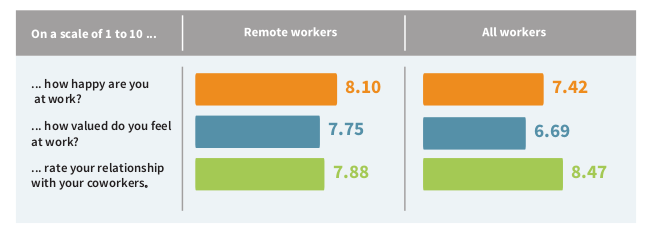Are you willing to put additional effort into tackling the challenges that arise when employing remote workers?
Recently I gave a talk on remote work at DTech 2018, a technology event that took place in Vila Real, Portugal. Working in a company for which remote work is bread and butter, and being a full-remote worker myself, I wanted to give my input on why would you want to work remotely, why remote work is a good idea in general, when it doesn’t function properly, and how to organize your company to make distributed teams efficient.
This is part two of my “On working remotely” post (click here for part one!), where I will talk about the things to look out for when organizing distributed teams in your company. I will share with you some studies done about remote work and tips on how to manage remote and on-site workers in your company and we’ll discuss some things that we have to look out for.
Working remote
First, let me give you an example of working remote…

… :)
I hope you enjoyed my remote pun. Now, jokes aside, you’re probably wondering what’s the answer to the question I posed in the title.
What do the studies say?
The most reasonable thing to do first, when trying to answer the question “should I allow remote work”, is to consider the facts. There are studies done about remote work, so let’s have a look at them. There are a bunch of them available online, but I’m going to reference three in this post:
- OwlLabs - State of Remote Work 2017
- OwlLabs - State of Remote Work 2018
- TINYpulse - What Leaders Need To Know About Remote Workers
First, let me talk a little bit about the first one from 2017. It’s a study done on around 1000 US-based responders across companies of all sizes and industries. Give it a quick glance to have context for my commentary below.
OwlLabs - State of Remote Work 2017
Working remotely is not that new thing, as 52% of responders work remotely at least once a week. Sales hire 66% more workers remotely than average. For IT the percentage of people hired remotely is around 12%.
Unexpectedly to me, fully distributed companies hire 33% faster than other companies. Personally, I think it’s due to the fact that distributed companies need to be more modern in order to manage remote as well as on-site workers, which translates into an improvement in other areas as well. So it’s more of a correlation than cause-and-effect. Also, companies that allow remote work offer more flexibility to their workers and are more attractive and competitive, which is why they have 25% lower employee turnover than companies who don’t!
There are downsides to remote working, unfortunately, and we need to talk about these as well. Due to the nature of full-remote work, it’s natural that employees don’t spend as much time communicating with their colleagues, which is why the study show’s that employees miss office conversations. Besides, a lot of information in the company is shared in the form of office chit-chat, and when you’re a remote worker, obviously, you miss a big chunk of that. All these things are the reason for the fact that it’s more difficult for remote workers to contribute to the company culture and feel like a part of the company.
It looks like there is a big demand for remote work as 65% of employees would like to work remotely at least once a month. This shows that remote work is something that workers want and expect from their employers. If you want your company to distinguish itself on the market (or maybe due to the number of companies already having remote work on their menu should I say to not lag behind) then remote work is a must-have. After all, you want your company to keep being competitive on the job market.
Good news is that managers rate the performance of remote workers equally good as the on-site ones. In my previous post, I pointed out that for most of us remote workers it feels like we can be much more productive when working from home due to the lack of distractions.
OwlLabs - State of Remote Work 2018
The study by the same company from 2018 is different from the 2017 one in the sense that this time the respondents represented employees from all continents (except Antarctica) and that the results were grouped based on that geographical data. Thanks to that we can see that there are no big differences in terms of remote work trends across the globe, with South America standing out with having 81% more fully-remote companies than the global average and 67% higher possibility of an employee being full-remote.
Apart from that, the new things we can learn from this study are the facts that:
- those who work remote at least once a month are 24% more likely to feel happy and productive in their roles than those who don’t or can’t work remotely.
- the #1 reason that people choose remote work in 2018 is productivity & focus.
Take a closer look at this study if you want to know more details about geographical differences in terms of remote work.
TINYpulse - What Leaders Need To Know About Remote Workers
Lastly, we’re going to look at data from the TinyPulse study:

The results are clear - remote workers feel happier and more valued at work. Unfortunately, they rate their relationship with coworkers worse than the average respondent, but that’s expected due to the communication issues we pointed out before.
Amazingly, TINYpulse found out that 91% of respondents say they’re more productive when working remotely!
So! I think that in general, the studies are pretty optimistic!
From what we have seen I can think of 3 issues that a company hiring remote workers must face and that is:
- Communication
- Organization of work
- Cultivating company culture
I want to talk a bit about how we could tackle these issues and I’m going to use the company I work for (that is Polcode) as an example.
Communication
Use proper software
First, you need to have software that allows you to communicate freely and efficiently. Ideally, this should be software that allows you to do unlimited video conferencing with a large number of people at the same time. Engagement of remote participants of a meeting is much better if everyone can freely speak with each other. Seeing each other would be perfect because it allows conversing also on a non-verbal level through body language. For communication, you can use Slack, Rocketchat, Zoom, Skype, Google hangouts or many others.
Encourage informal communication
At Polcode we believe that
(…) making friends on private grounds will also increase openness in business matters. - Małgorzata Pająk, Polcode Board Member
So, we do everything we can to not only encourage communication within the teams and the whole company but also to encourage informal communication. We have a closed Facebook group, where everyone is able to talk freely and post whatever they want. We use Rocketchat where everyone is free to create their own off-topic channels. We have no moderation anywhere, we encourage jokes (even though most of them are not funny), we have free speech all the way. Indeed, having a friendly and relaxed atmosphere makes it easier to work with each other in business.
Organization
It’s necessary to have your onboarding process properly set up. The goal here is to make your workers feel like a part of the company as soon as possible and also to make them productive as soon as possible. Have a step-by-step list of things every employee has to do when joining the company and assign a person who will be responsible for making sure that this person is executing this list.
Next, use software, which will guarantee that a team consisting of remote as well as on-site workers will be able to seamlessly deliver a project.
- Git repository management - Github, Gitlab, BitBucket …
- Project management tools - JIRA, Trello, Pivotal, Redmine …
- etc.
Cultivating company culture
If you want employees to be engaged you need to make them feel like a part of the company. In Polcode we put a lot of effort into this, for example, by organizing a bunch of events that both remote and on-site workers can attend.
We organize annual company retreats which take a couple of days. We do quarterly workshops. We meet monthly in offices for integration parties. We send out welcome packages to new employees. We have a Facebook group, off-topic channels on RocketChat. Each month we have an internal newsletter, which includes some of the exciting things that are happening in the company. All this makes us feel more integrated.
Should I employ remotely?
Now to the main point!
Are you willing to put additional effort into tackling the challenges that arise when employing remote workers?
If yes, then definitely you should employ remote workers. Besides having a bigger pool of employees to choose from (not just your city and surroundings, but theoretically the whole world) there are another bunch of advantages described above, like the possibility of having smaller employee turnover or better employee satisfaction and performance. Just remember to handle communication properly and take care of your remote workers a little bit more than your on-site workers.
Summary
Thanks for reading and please share your experiences with remote work in the comments below! I will be glad to hear your opinion on this subject!
Przemek